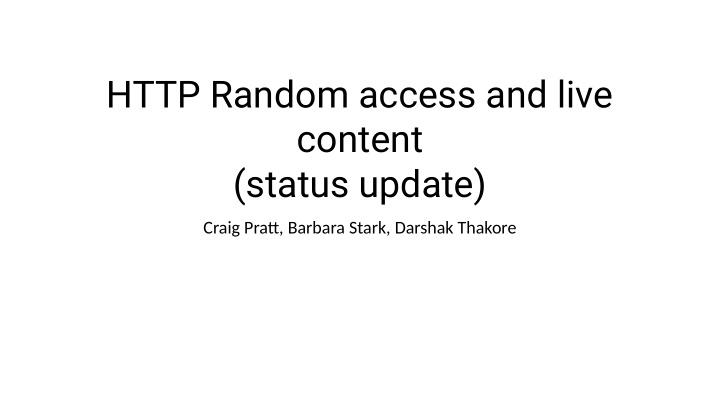



HTTP Random access and live content (status update) Craig Pratu, Barbara Stark, Darshak Thakore
WG draft • Review requested at IETF 98 • No specifjc concerns/comments received • Working on testjng the “protocol” • Main focus on checking ”intermediary” behavior
Test framework • Creatjng a “contjnuous” live video stream • Hosted thru a • CDN • Caching proxy • Custom client that issues the “live” byte range requests • Test • that the implementatjon works as expected • Intermediaries (cdn, cache) work as expected • Send out observatjons/results
Next steps • Any feedback/questjons? • Issue LC ? • Keep it open tjll we fjnish the testjng
Background slides
How it works • Client uses Range semantjcs to determine accessible bytes Indicates representatjon length unknown REQUEST RESPONSE HEAD /my_resource HTTP/1.1 HTTP/1.1 206 Partial Content Range: bytes=0- Content-Range: bytes 0-99408383/* Content-Length: 99398384 • Client atuempts to “discover” live random access support Provides “large Supportjng server number” to indicate “echoes” back same live random access “large number” REQUEST RESPONSE GET /my_resource HTTP/1.1 HTTP/1.1 206 Partial Content Range: bytes=99400000-9223372036854775Content-Range: bytes 99400000-9223372036854775/* Transfer-Encoding: chunked
“backward” compatibility • ”non supportjng” server will respond as per RFC7233 Non-supportjng server Provides “large sends back what it can number” to indicate support live random access REQUEST RESPONSE GET /my_resource HTTP/1.1 HTTP/1.1 206 Partial Content Range: bytes=99400000-9223372036854775Content-Range: bytes 99400000- 99634867 /* Transfer-Encoding: chunked
Recommend
More recommend